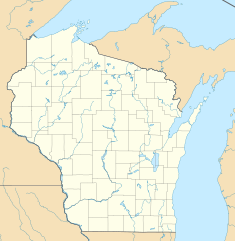Kewaunee Power Station
| Kewaunee Power Station | |
|---|---|

Kewaunee Power Station
|
|
| Country | United States |
| Location | Town of Carlton, Kewaunee County, near Kewaunee, Wisconsin |
| Coordinates | 44°20′32″N 87°32′10″W / 44.34222°N 87.53611°WCoordinates: 44°20′32″N 87°32′10″W / 44.34222°N 87.53611°W |
| Status | Closed |
| Commission date | June 16, 1974 |
| Decommission date | May 7, 2013 |
| Construction cost | US$776.15M (2007 prices) |
| Operator(s) | Dominion Generation |
| Nuclear power station | |
| Reactor type | Pressurized water reactor |
| Reactor supplier | Westinghouse |
| Power generation | |
| Nameplate capacity | 556 MW |
|
Website Kewaunee Power Station |
|
The Kewaunee Power Station, now closed, occupies a 900-acre site in Carlton, Wisconsin, 27 miles southeast of Green Bay, Wisconsin, Kewaunee was the fourth nuclear power plant built in Wisconsin, and the 44th built in the United States. Due to falling electricity prices resulting from the falling price of natural gas, the plant ceased operation May 7, 2013.
The plant's original operator was Wisconsin Public Service and it was owned by Wisconsin Public Service (59%) and Alliant Energy (41%). From 2000 to July 2005, the plant was operated by Nuclear Management Company, of Hudson, Wisconsin. The plant is now owned by Dominion Resources of Richmond, Virginia. In 2008, Dominion applied to the Nuclear Regulatory Commission for an extension of its operating license for an additional 20 years. The license was extended until 2033.
On April 27, 2006, there was a small water leak at the plant, though no radioactive material was released.
On October 22, 2012, Dominion Resources announced they would shut down and decommission the plant in Mid-2013. Dominion's chairman and CEO said "the decision was based purely on economics. Dominion was not able to move forward with our plan to grow our nuclear fleet in the Midwest to take advantage of economies of scale". Lower natural gas costs and resultant lower electricity prices created an electricity market in which the plant could not compete. The plant came offline permanently on May 7, 2013. Plans for decommissioning are uncertain: as a private owner rather than a public utility, Dominion cannot rely on charges imposed on utility customers by state regulators; however, the firm has a substantial reserve fund earmarked for this purpose and a cause of action against the Department of Energy for failure to remove spent fuel. There is also the chance that the energy market might improve due to economic or political changes.
The SAFSTOR (SAFe STORage) nuclear decommissioning option was selected. During SAFSTOR, the de-fuelled plant is monitored for up to sixty years before complete decontamination and dismantling of the site, to a condition where nuclear licensing is no longer required. During the storage interval, some of the radioactive contaminants of the reactor and power plant will decay, which will reduce the quantity of radioactive material to be removed during the final decontamination phase. A reduced workforce will move fuel assemblies from the reactor into the spent fuel pool.
...
Wikipedia

